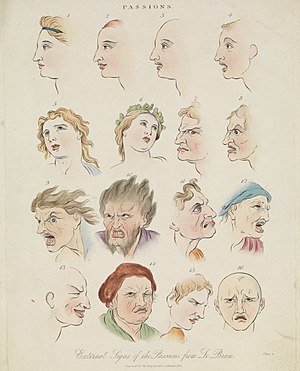
Back Emosie Afrikaans Emotion ALS Emoción AN شعور Arabic انفعال (سايكولوجيا) ARZ আৱেগ Assamese Emoción AST Emosiya Azerbaijani هیجان AZB Эмоция Bashkir

An mga emosyon iyo an kamugtakan kan pag-iisip na dara kan mga pagbabago sa neuropisyolihikal, manlaenlaen na asosyado sa kaisipan, namamatian, simbag na gawe, asin an digri nin pleasure o displeasure.[1][2][3][4] Mayo sa ngunyan nin siyentipikong konsensus pag-abot sa kahulugan.[5][6] An emosyon parating intertwined sa mood, temperament, personalidad, disposisyon, o pagkamalinalang.[7]
- ↑ Panksepp, Jaak (2005). Affective neuroscience: the foundations of human and animal emotions ([Reprint] ed.). Oxford [u.a.]: Oxford Univ. Press. p. 9. ISBN 978-0195096736.
Our emotional feelings reflect our ability to subjectively experience certain states of the nervous system. Although conscious feeling states are universally accepted as major distinguishing characteristics of human emotions, in animal research the issue of whether other organisms feel emotions is little more than a conceptual embarrassment
- ↑ "Emotion in the perspective of an integrated nervous system". Brain Research. Brain Research Reviews 26 (2–3): 83–86. May 1998. doi:. PMID 9651488.
- ↑ Ekman, Paul; Davidson, Richard J. (1994). The Nature of emotion: fundamental questions. New York: Oxford University Press. pp. 291–293. ISBN 978-0195089448.
Emotional processing, but not emotions, can occur unconsciously.
- ↑ Schacter, Daniel L.; Gilbert, Daniel T.; Wegner, Daniel M. (2011). Psychology (2nd ed.). New York: Worth Publishers. p. 310. ISBN 978-1429237192.
- ↑ Cabanac, Michel (2002). "What is emotion?". Behavioural Processes 60 (2): 69–83. doi:. PMID 12426062. "There is no consensus in the literature on a definition of emotion. The term is taken for granted in itself and, most often, emotion is defined with reference to a list: anger, disgust, fear, joy, sadness, and surprise. [...] I propose here that emotion is any mental experience with high intensity and high hedonic content (pleasure/displeasure).".
- ↑ Lisa Feldman Barrett; Michael Lewis; Jeannette M. Haviland-Jones, eds. (2016). Handbook of emotions (Fourth ed.). New York. ISBN 978-1462525348. OCLC 950202673.
- ↑ Averill, James R. (February 1999). "Individual Differences in Emotional Creativity: Structure and Correlates" (in en). Journal of Personality 67 (2): 331–371. doi:. ISSN 0022-3506. PMID 10202807.